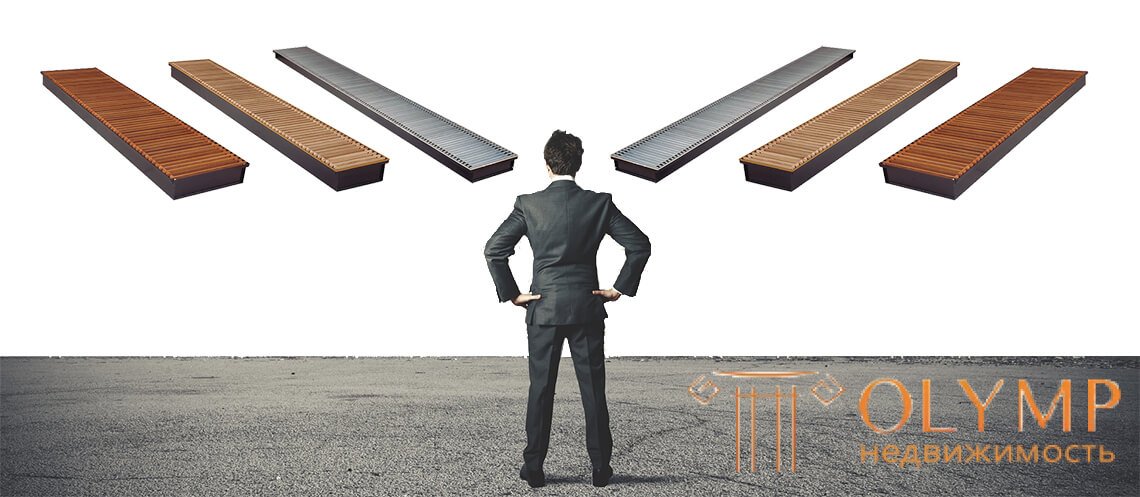
Floor convectors are one of the most modern and designer radiators that do not occupy space in the interior. Fan coils are made so that it is possible to mount them to the floor, so that you can walk on them, besides the fact that they also warm.
Buy floor convectors in Kiev, Odessa, Dnepropetrovsk, Kharkov and other regions in Ukraine, as well as download the catalog, the price of embedded radiators you can on our website. At the heart of robots battery sex is a physical phenomenon in nature - convection (movement). This movement of air masses under pressure, depending on their temperature. Cold air is heavier than warm air and will always be below it, and warm air in turn will rise higher. Convection is natural and forced. Forced convection does not occur by itself, there must be some additional mechanism for its occurrence. In our case, these are fans. From here comes the fact that there are two types of batteries in the floor: floor convectors, heating, natural convection (without a fan), and floor convectors with forced airflow. The presence of the fan gives the convector power at least 3 times more than the device without it. The floor fan coil without a blower basically performs the function of additional heating, it is thin, but effective in the presence of panoramic windows. Where other heaters cannot help, the floor convector without a fan at its low power can cope with cutting off cold air from a window, with condensate (misting from temperature differences), uniform distribution of heated air throughout the room where it is located, without closing a beautiful view from your window. Forced airflow in addition to all the above functions and capabilities will also provide high-quality heating. Floor convectors with airflow will be very powerful and will independently be able to provide large areas with their heat.
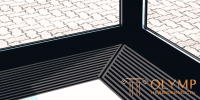

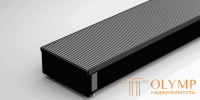






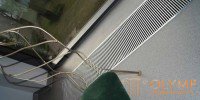
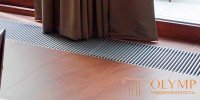



Floor convectors can be used in almost all of the rooms that use conventional radiators. Considering that, built-in radiators are intended to be installed in the floor and do not occupy space in the interior of their main place in front of large floor-to-ceiling windows or, as they are also called, panoramic, attic, stained-glass windows, and French. The concealment of a built-in heater in front of a large opening will allow you to enjoy the beautiful view from it, without worrying about condensation (fogging) either, since the floor convector will serve as a thermal curtain and will effectively eliminate this problem. CLIMATE CONTROL
Private houses
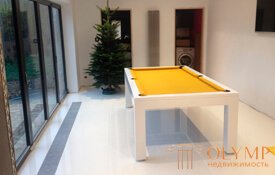
Apartments
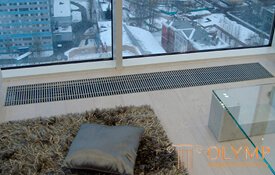
Children's rooms

Kitchens
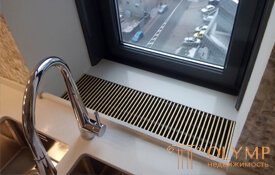
Bathrooms

Showrooms

Halls

Car dealerships

Moto salons

The shops

Office buildings

Restaurants
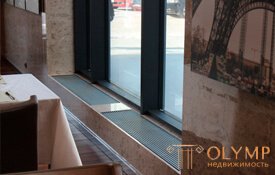
Hotels

Entertainment centers

Stadiums
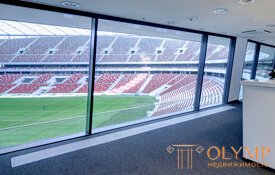
Gyms

Religious buildings
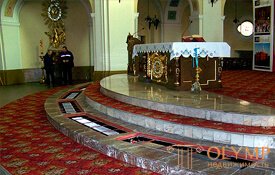
Pools

Greenhouses

Winter gardens

The floor convector is primarily a heating radiator and therefore the first main ego function is to heat the room where it stands. It also creates a heat-air curtain as it absorbs cold and raises heat, the second main function comes from here - cutting off cold air. When the warm air is raised, an imperceptible blowing of a window or wall is created, in front of which a recessed floor convector stands in front of it, thereby removing condensation and removing moisture. Since the floor convectors (batteries) in the floor, their only visible element is a decorative grille, which can be anything under any floor coverings, here also a decorative design function emerges.
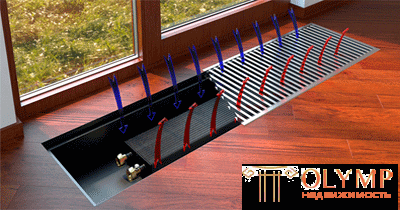
The principle of operation of the floor convectors lies in the fact that they are the lowest point of the room, and since we know that the cold air is heavier than the warm one, it will always roll into the heating box.
Depending on the type of convection, the floor convectors can be equipped with a fan. Convection is natural and forced. If there is no fan in the convector, it works according to the principle of natural convection, and vice versa - if a fan is built into the convector, then it works as a device with forced convection.
Floor without fan (natural convection)
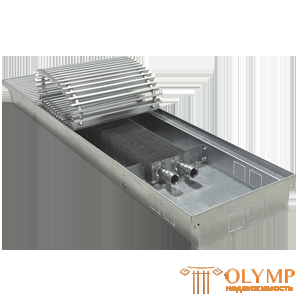
Interfloor with fan (forced convection)
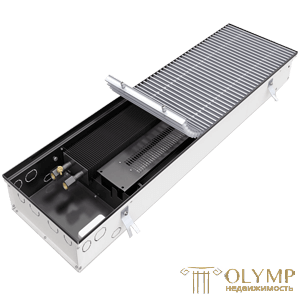
In addition to the differences in convection, flooring convectors with and without airflow have a few more. Outwardly, they cannot be distinguished, since the entrails are hidden by a decorative lattice, but their effectiveness otherwise will be different. If you take built-in convectors without blowing , then they usually go as an addition to heating. They are thin and their main functions will be to remove condensate from the window and cut off cold air from it. These devices work well with any other heating devices, especially with a warm floor. As for the built-in convectors with a fan, unlike fanless, they are powerful and completely independent for heating any rooms. In addition to the functions of cutting off cold air, removing condensate from the glasses, they will qualitatively heat the room. The difference in power between these two species will be at least three times. The fan of the floor convector forces the air to move faster to heat it with a heat exchanger. Its main function is to draw air into the convector box and direct it to the heat exchanger for heating. The heat exchanger of the floor convector is designed so that any air flow that passes through it heats up very quickly and efficiently.
The design of the floor convector without fan

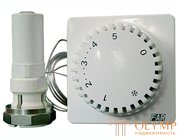
Thermostatic head with remote control
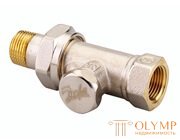
Stopcock
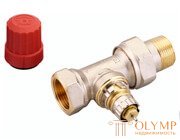
Thermostatic faucet
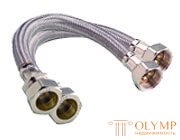
Flexible hoses
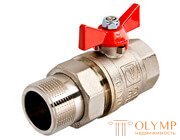
Crane with an American
Design of the floor convector with fan
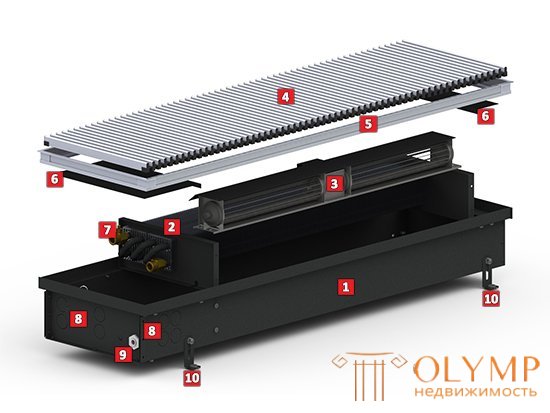
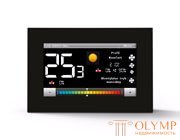
Room thermostat
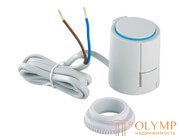
Servo
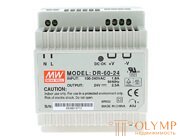
Transformer

Stopcock

Thermostatic faucet

Flexible hoses

Want to make the right choice and buy a floor convector without any future complaints about his work? Then follow the basic rules of selection or trust our experts!
Like any other heating device, the floor convector has its own thermal characteristics and size range. The first thing to start with is to choose this from the size of the place where the inside-field battery will stand and the required heat transfer to heat the room. Below we will give an example and a formula by which you can calculate the heat transfer that is necessary for your room.
Having determined the boundary dimensions of the depth, length and width of the space for the built-in convector, you will know which maximum dimensions you can put yourself. And knowing how much heat you need to warm the room, you can more specifically choose the size of the underfloor heating and the type of convection. Convectors with natural and forced convection have different heat output for identical sizes.
The capacity of a radiator built into the floor will also depend on the temperature of the heat transfer medium (water) and the intensity of the air flow generated around the heat exchanger. Floor convectors can be used in various heating systems operating in a wide range of coolant temperatures - from 45 to 100 ° C and a wide pressure range - up to 16 atmospheres. In a private house, you yourself can regulate the temperature of the heat carrier (water) in your heating system on the boiler. As for apartments, according to all standards, the temperature should be at least 75 ° C.
Also, when selecting, consider the presence of other heating devices in the room: conventional batteries, underfloor heating, etc. These devices have their own indicator of heat, which they give out. Knowing the total heat transfer required in the room, you take away from it the heat transfer of devices that are already in it. The difference between these two indicators, and there will be that heat transfer which convectors vnutripolnye should issue. Also consider the size of the window in front of which the floor battery will stand. The floor convector should be no shorter than 3/4 of the width of the window itself in order to properly perform its functions. This request should be especially taken into account if you sweat windows or have the possibility of their sweating.
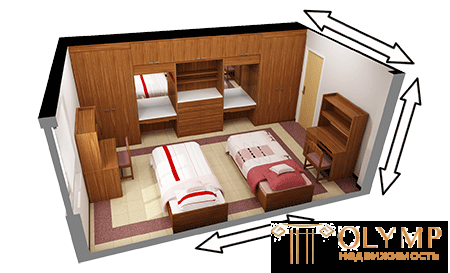
In order to proceed to the calculations, first of all, it is worth clarifying for what purposes the floor convector is needed: as an additional heating or as a source of main heat in the room.
In the case of installation, floor convectors as the only source of heat supply should take into account the figure of 40 W per cubic meter. This means that it takes 40 watts of energy to heat one cubic meter of space.
So how to calculate the power of the convector heating?
For a complete calculation you need to know the size of the room: the height of the ceiling, the length and width of the room. Multiplying all the data, we obtain the volume of the room, then multiply this figure by 40 and get the value of the required power.
EXAMPLE
For clarity, we will carry out a small calculation: a floor radiator is needed for heating a room with a panoramic opening, the area of the room is 10 square meters with a ceiling height of 4 meters. Substituting the values in the formula and get: 10 multiply by 4 and multiply by 40 (10 * 4 * 40) in the end we get 1600 watts. The maximum power for such a room would be 2 kW.
If you have poor insulation, a glass wall or more than 3 windows then increase the rate from 40 watts per cubic meter. at 45 watts per cubic meter.
Floor-mounted radiators require special installation. It is best to entrust this business to a professional.
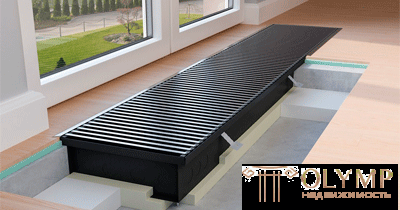
For the installation of "floor convectors", first prepared cavities in the floors or openings under raised floors along the length near the window. The floor convector should not be shorter than 3/4 of the width of the window itself.
The distance from the window opening should be at least 8 cm. Ideally - 20 cm. Calculate the installation so that the curtains or blinds do not divide the built-in radiator in half, they should be up to the convector from the panorama. The channel should be 3 to 5 cm larger on each side than the size of the heater itself. That is, if the device is 20 cm wide, 9 cm deep and 100 cm long, the niche should hit at least 26 cm wide, 12 cm deep and 106 cm long. Before installation, be sure to cover the floor radiators with a protective cap that fits in place of the grille. The protective tire will protect the built-in battery from deformation of the box when casting with concrete, as well as from the ingress of building materials, dust and dirt, which in the future may adversely affect the operation of the device. Each manufacturer after unpacking in the box should be accompanied by instructions and warranty. Each brand describes its installation process in its own way, but it all comes down to a few general guidelines, which we have combined and indicated below.
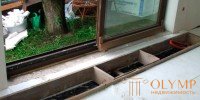



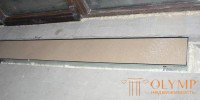

A niche in the floor is necessary for the proper placement and efficient operation of floor convectors. It is necessary to prepare it at the design stage, because it is easier to leave a void when pouring the screed than to cut the concrete and risk the integrity of the base. Although in the finished floor you can make a niche of appropriate sizes, however, this work should be done with great care so as not to disturb the waterproofing layer.
Kravets M. Yu. - Installer
1 If you purchased or wish to purchase a forced-air convector, you should consider that the heat exchanger should be placed on the opposite side of the window.
2 The radiator position during installation must be extremely horizontal.
3 It is impossible to independently change the orientation of the device (turn it over).
4 Do not use any "foreign" parts in the installation, only native flexible hoses, shut-off valves and so on.
5 The maximum allowed protrusion of the built-in battery for the floor is 1 mm. Ideally, it should be level with the floor.
6 It is very important to correctly calculate the size of the niche under the floor convector. All parameters are calculated using the same formula: convector size + 30 mm clearance for fit.
7 The heat exchanger cuts into the heating system by means of a screw thread and a valve.
8 Correct installation means that all the parts are in place, the upper edges of the box (case) are not bent and do not go beyond the niche, the grid does not interfere with the residents of the house, the heat ventilation takes place without failures and interference.
9 To protect internal parts from dust and other repair dirt, a protective cover panel is installed on the floor convector. We recommend that you remove it after the completion of all installation work.
10 The installation bolts that are included in the delivery set of the floor convector are not intended to fix the convector in a niche. They serve for horizontal alignment of the radiator.
| Manufacturer | Model | Sizes, mm | Cost in EURO | Price complete, EUR | |||||
|---|---|---|---|---|---|---|---|---|---|
| Width | Depth | Length | Convector | Grate and frame | Transformer | Thermostat | |||
| TM Convector | CBT | 306 | 85 | 2000 | 400 | 130 EUR. | 120 | 58 | 708 |
| Carrera | SV300.90.2000 | 300 | 90 | 2000 | 400 | 155 EUR. | 108 | 58 | 721 |
| Polvax | KV300.90.2000 | 300 | 90 | 2000 | 465 | 176 EUR. | 110 | 58 | 809 |
| Fancoil | FCF300.90.2000 | 300 | 90 | 2000 | 498 | 235 EUR. | 110 | 54 | 897 |
| Hitte | Vent | 305 | 105 | 2000 | 670 | 136 | 40 | 195 | 1041 |
| Intcon | Ventherm | 260 | 90 | 1950 | 1203 | In set | In set | 182 | 1385 |
| Verano | Turbo VKN5 | 280 | 90 | 1950 | 844 | 347 EUR. | 55 | 250 | 1496 |
| Isan | New Practic FRT | 250 | 90 | 2000 | 1177 | In set | 71 | 250 | 1498 |
| Jaga | CLCM | 180 | 85 | 1800 | 1608 | In set | 97 | 299 | 2004 |
| Mohlenhoff | QSK | 260 | 110 | 2000 | 1532 | 430 | In set | 215 | 2177 |
Примером в табличке выше Вам были наведены технические и ценовые сравнения внутрипольных конвекторов (встраиваемых в пол радиаторов) как с естественной циркуляцией воздуха, так и с принудительным обдувом.
In short, you can summarize. As for prices, the most low-cost brands are domestic brandy and the Kirovograd convector is the first among them. The rest is more expensive, but not significant, and the price is almost the same. European brands are much more expensive. The most expensive brand of domestic batteries is the German brand Mohlenhoff. Following the price after the Melenhof convector are the Belgian brand Jaga and another German brand Kampmann. It can be concluded that starting from Germany and beyond, convectors will be more and more expensive.
If we take the technical parameters, in the convectors without a fan, Ukrainian manufacturers indicate heat transfer more. Why so, the exact answer, unfortunately, we can not give. Each manufacturer suggests their own facts and proves that the ego brand is better, more reliable and all the power parameters are verified by tests. But what is special about them compared to Europeans cannot be said, stating that they are trying to develop and take all the best qualities of the most popular brands in Europe. Probably, these are consequences of the big competition of domestic producers in our market. In convectors with air injection, the sound pressure level is the smallest among the Czech brand Isan and one of the leaders at the price of the German brand Kampmann, followed by Jaga (Belgium), Mohlenhoff (Germany) and another brand Verano (Poland). Correct or incorrect data of power and noise of convectors of Ukrainian production with 100% accuracy cannot be guaranteed by any of the trading organizations, since special conditions, premises and equipment are needed for the check, all are based on the declared parameters from the production. Everyone praises the brand that is most profitable for him to sell. Ukraine is in such conditions that it cannot be developed. Over time, all domestic convectors of Ukrainian production will be more qualitative and reliable to enter the European markets in the future. We guarantee with confidence that we will select built-in and any other convectors no matter what kind of production is most correct and qualitatively based on their many years of experience and proven practice of heating convectors, as well as customer reviews.
Что бы оставить комментарий войдите
Комментарии (0)